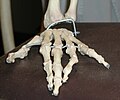Phalanx bone
Phalanx bones' are the bones that form the fingers of the hands and the toes of the feet. Each finger and toe, except for the thumb and big toe, has three phalanx bones, which are referred to as the proximal, middle, and distal phalanges. The thumb and big toe have only two phalanx bones, lacking the middle phalanx. These bones play a crucial role in the movement and dexterity of the hands and feet.
Structure[edit]
The structure of the phalanx bones is similar to most long bones in the body, having a shaft and two ends. The ends are known as the base and the head. The base is the part of the bone that is closer to the wrist or ankle, and the head is the part that is closer to the fingertips or toes. The surface of the phalanx bones is covered with articular cartilage at the joints, which helps in smooth movement and reduces friction.
Function[edit]
The primary function of the phalanx bones is to provide support and flexibility to the fingers and toes. These bones work in conjunction with the muscles and tendons in the hand and foot to allow for a wide range of movements, from grasping objects to walking. The arrangement of the phalanges also contributes to the gripping ability and the fine motor skills of the hands.
Clinical Significance[edit]
Phalanx bones are prone to fractures, which are common injuries that can occur from direct impacts or falls. Treatment for phalanx fractures depends on the severity and location of the fracture and may include immobilization, physical therapy, or surgery. Conditions such as osteoarthritis can also affect the phalanx bones, leading to pain and reduced mobility.
Development[edit]
The development of the phalanx bones begins in the embryonic stage with the process of endochondral ossification. This is where cartilage is gradually replaced by bone. The growth of the phalanges continues throughout childhood and adolescence, with growth plates located at the ends of the bones.
Evolution[edit]
The phalanx bones have evolved to support the diverse range of functions of the hands and feet in different species. In humans, the structure of the phalanges allows for precise movements and manipulation of objects, which is a key aspect of human tool use and cultural development.
-
Phalanx_bone
-
Phalanx_bone
-
Phalanx_bone
-
Phalanx_bone
-
Phalanx_bone
-
Phalanx_bone
-
Phalanx_bone
-
Phalanx_bone
-
Phalanx_bone
-
Phalanx_bone
-
Phalanx_bone
-
Phalanx_bone
Ad. Transform your life with W8MD's Budget GLP-1 injections from $75


W8MD offers a medical weight loss program to lose weight in Philadelphia. Our physician-supervised medical weight loss provides:
- Weight loss injections in NYC (generic and brand names):
- Zepbound / Mounjaro, Wegovy / Ozempic, Saxenda
- Most insurances accepted or discounted self-pay rates. We will obtain insurance prior authorizations if needed.
- Generic GLP1 weight loss injections from $75 for the starting dose.
- Also offer prescription weight loss medications including Phentermine, Qsymia, Diethylpropion, Contrave etc.
NYC weight loss doctor appointmentsNYC weight loss doctor appointments
Start your NYC weight loss journey today at our NYC medical weight loss and Philadelphia medical weight loss clinics.
- Call 718-946-5500 to lose weight in NYC or for medical weight loss in Philadelphia 215-676-2334.
- Tags:NYC medical weight loss, Philadelphia lose weight Zepbound NYC, Budget GLP1 weight loss injections, Wegovy Philadelphia, Wegovy NYC, Philadelphia medical weight loss, Brookly weight loss and Wegovy NYC
|
WikiMD's Wellness Encyclopedia |
| Let Food Be Thy Medicine Medicine Thy Food - Hippocrates |
Medical Disclaimer: WikiMD is not a substitute for professional medical advice. The information on WikiMD is provided as an information resource only, may be incorrect, outdated or misleading, and is not to be used or relied on for any diagnostic or treatment purposes. Please consult your health care provider before making any healthcare decisions or for guidance about a specific medical condition. WikiMD expressly disclaims responsibility, and shall have no liability, for any damages, loss, injury, or liability whatsoever suffered as a result of your reliance on the information contained in this site. By visiting this site you agree to the foregoing terms and conditions, which may from time to time be changed or supplemented by WikiMD. If you do not agree to the foregoing terms and conditions, you should not enter or use this site. See full disclaimer.
Credits:Most images are courtesy of Wikimedia commons, and templates, categories Wikipedia, licensed under CC BY SA or similar.
Translate this page: - East Asian
中文,
日本,
한국어,
South Asian
हिन्दी,
தமிழ்,
తెలుగు,
Urdu,
ಕನ್ನಡ,
Southeast Asian
Indonesian,
Vietnamese,
Thai,
မြန်မာဘာသာ,
বাংলা
European
español,
Deutsch,
français,
Greek,
português do Brasil,
polski,
română,
русский,
Nederlands,
norsk,
svenska,
suomi,
Italian
Middle Eastern & African
عربى,
Turkish,
Persian,
Hebrew,
Afrikaans,
isiZulu,
Kiswahili,
Other
Bulgarian,
Hungarian,
Czech,
Swedish,
മലയാളം,
मराठी,
ਪੰਜਾਬੀ,
ગુજરાતી,
Portuguese,
Ukrainian












